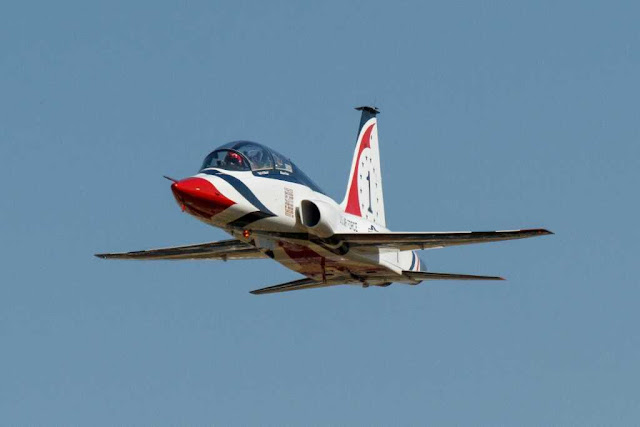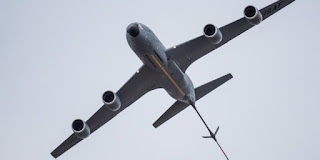 |
| T-38 Talon over Edwards AFB. (U.S. Department of Defense) |
The Northrop T-38 Talon is a two-seat, twinjet supersonic jet trainer. It was the world's first supersonic trainer and is also the most produced. The T-38 remains in service as of 2020 in several air forces.
 |
| Pilots of a T-38 Talon exit the plane for a refueling before continuing on to its next destination April 28, 2015, at Scott Air Force Base, Ill. (Senior Airman Tristin English) |
The United States Air Force (USAF) operates the most T-38s. In addition to training USAF pilots, the T-38 is used by NASA. Pilots of other NATO nations fly the T-38 in joint training programs with USAF pilots.
The T-38 is of conventional configuration, with a small, low, long-chord wing, a single vertical stabilizer, and tricycle undercarriage. The aircraft seats a student pilot and instructor in tandem, and has intakes for its two turbojet engines at the wing roots.
 |
| (Alan Wilson / Wki Common) |
Its nimble performance has earned it the nickname white rocket. In 1962 the T-38 set absolute time-to-climb records for 3,000, 6,000, 9,000 and 12,000 meters, beating the records for those altitudes set by the F-104 in December 1958. (The F-4 Phantom beat the T-38's records less than a month later.)
The USAF Strategic Air Command (SAC) had T-38s in service from 1978 until SAC's 1991 inactivation. These aircraft were used to enhance the career development of bomber and tanker copilots through the "Accelerated Copilot Enrichment Program." They were later used as proficiency aircraft for all B-52, B-1, Lockheed SR-71, U-2, Boeing KC-135, and KC-10 pilots. SAC's successors, the Air Combat Command (ACC) and the Air Force Global Strike Command (AFGSC), continue to retain T-38s as proficiency aircraft for U-2 pilots and B-2 pilots, respectively.
The Air Training Command's (ATC) successor, the Air Education and Training Command (AETC), uses the T-38C to prepare pilots for the F-15C Eagle and F-15E Strike Eagle, the F-16 Fighting Falcon, B-52 Stratofortress, B-1B Lancer, B-2 Spirit, A-10 Thunderbolt, F-22 Raptor and F-35 Lightning II.
Most T-38s built were of the T-38A variant, but the USAF also had a small number of aircraft converted for weapons training (designated AT-38B), which were fitted with a gunsight and could carry a gunpod, rockets, or bombs on a centerline pylon.
Variants
- N-156T: Northrop company designation.
- YT-38: Prototypes, two built with YJ85-GE-1 engines, later designated YT-38A and four pre-production aircraft with YJ-85-GE-5 engines, later designated T-38A.
- T-38A: Two-seat advanced training aircraft, production model, 1,139 built.
- T-38A(N): Two-seat astronaut training version for NASA. See T-38N below.
- AT-38A: A small number of T-38As were converted into weapons training aircraft.
- DT-38A: A number of US Navy T-38As were converted into drone directors.
- GT-38A: Permanently grounded aircraft, often due to flight or ground mishap, converted into ground procedural trainers or aircraft maintenance trainers.
- NT-38A: A small number of T-38As were converted into research and test aircraft.
- QT-38A: Unmanned target drone aircraft.
- AT-38B: Two-seat weapons training aircraft.
- T-38C: A T-38A with structural and avionics upgrades.
- T-38M: Modernized Turkish Air Force T-38As with full glass cockpit and avionics, upgraded by Turkish Aerospace Industries under the project codename "ARI" (Turkish: Arı, for Bee).
- T-38N: Former USAF T-38As bailed to NASA and T-38As directly assigned to NASA that received an Avionics Upgrade Program (AUP), modernizing communications and navigation systems, replacing outdated avionics, and adding a weather radar, flight management system, altitude alert systems, and modern controls and displays.
- N-205: "Space trainer" variant proposed in May 1958, with triple rocket engines for vertical launch, and capable of Mach 3.2 and a maximum altitude of 200,000 feet (61,000 m).
- ST-38 or N-205B: Revised proposal in April 1963 for the new Aerospace Research Pilot School, with a rolling takeoff, top speed of Mach 3.3 and a ceiling of 285,000 feet (87,000 m), high enough to qualify its pilots for astronaut wings.
- T-38 VTOL: Proposed vertical takeoff variant with four lift nozzles behind the pilot.
 |
| A T-38 Talon, in a Thunderbirds scheme, performing at the Alliance Air Show in Fort Worth, Texas in 2014. (Balon Greyjoy) |
As of September 30, 2017, 503 T-38s were still operational with the USAF, with many more in operation around the world.
Most of the USAF variant aircraft (T-38A and AT-38B) have been converted to the T-38C through an avionics upgrade program. Improvements include the addition of a HUD, GPS, INS (Inertial Navigation System), and TCAS. Most jets have also received PMP (a propulsion modification to improve low-altitude engine thrust). Approximately a third of the fleet (those that experience more severe usage) are currently undergoing structural replacements and upgrades, as well as receiving new wings, to extend their service life to 2029.
 |
| A T-38 Talon, in a Thunderbirds scheme, performing at the Alliance Air Show in Fort Worth, Texas in 2014. (Balon Greyjoy) |
When production ended in 1972, 1,187 T-38s had been built. Since its introduction, it is estimated that some 50,000 military pilots have trained on this aircraft. The USAF remains one of the few armed flying forces using dedicated supersonic final trainers, as most, such as the US Navy, use high subsonic trainers.
 |
| A T-38 Talon, in a Thunderbirds scheme, performing at the Alliance Air Show in Fort Worth, Texas in 2014. (Balon Greyjoy) |
Besides the USAF, USN and NASA, other T-38 operators included the German Air Force (Luftwaffe), the Portuguese Air Force, the Republic of China Air Force, Republic of Korea Air Force and the Turkish Air Force.
 |
| A T-38 Talon, in a Thunderbirds scheme, performing at the Alliance Air Show in Fort Worth, Texas in 2014. (Balon Greyjoy) |
As of 2020, the T-38 has been in service for over 50 years with its original operator, the United States Air Force.
In September of 2018, USAF announced the replacement of the Talon by the Boeing T-7 Red Hawk with phaseout to begin in 2023.
 |
| A T-38 Talon, in a Thunderbirds scheme, performing at the Alliance Air Show in Fort Worth, Texas in 2014. (Balon Greyjoy) |
General characteristics
- Crew: 2
- Length: 14.135 m
- Wingspan: 7.70 m
- Height: 3.924 m
- Wing area: 16 m2
- Empty weight: 3,266 kg
- Gross weight: 5,361 kg
- Max takeoff weight: 5,485 kg
- Powerplant: 2 × General Electric J85-5A afterburning turbojet engines, 2,050 lbf (9.1 kN) thrust each dry, 2,900 lbf (12,899.84 N) with afterburner (J85-5R after PMP modification)
Performance
- Maximum speed: 746 kn (858 mph, 1,382 km/h)
- Maximum speed: Mach 1.3
- Range: 991 nmi (1,140 mi, 1,835 km)
- Service ceiling: 50,000 ft (15,000 m)
- Rate of climb: 33,600 ft/min (171 m/s)
- Wing loading: 69.53 lb/sq ft (339.5 kg/m2)
- Thrust/weight: 0.65












EmoticonEmoticon